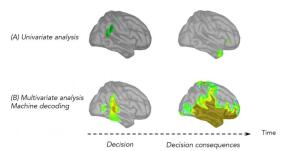by
Lauren Dubinsky, Senior Reporter | February 05, 2018

The traditional univariate analysis of
magnetoencephalography activity
recorded in human subjects when
they perform a simple task.
Artificial intelligence may not as accurate as it's thought to be — at least when it comes to decoding the human brain, according to a new study published in the PNAS journal.
"We became increasingly suspicious of the results presented in the literature using machine learning to investigate the neural bases of language," Anne-Lise Giraud, professor at the University of Geneva, told HCB News.
Giraud and her team found that the brain doesn't necessarily use the regions that machine learning identified to perform a task. Machine learning is effective for decoding mental activity, but it's not able to understand the specific information processing mechanisms in the brain.



Ad Statistics
Times Displayed: 174440
Times Visited: 3180 For those who need to move fast and expand clinical capabilities -- and would love new equipment -- the uCT 550 Advance offers a new fully configured 80-slice CT in up to 2 weeks with routine maintenance and parts and Software Upgrades for Life™ included.
The team had about 50 people listen to a continuum of syllables ranging from BA to DA. The individuals then underwent functional MR exams and magnetoencephalography to evaluate how the brain behaves when the acoustic stimulus is very clear and when it is unclear.
They observed that regardless of how difficult it was to classify the syllable that was heard, the decision always engages a small area of the posterior superior temporal lobe.
The team then asked whether the information on the identity of the syllable was only locally present (as shown by the experiment) or whether it's more generally present in the brain (as machine learning suggests). To test this, they performed the BA/DA experiment again, but on people with electrodes directly implanted in their brains for medical reasons.
Only the areas in the posterior superior temporal lobe were active, which supported the initial experiment. However, when a machine learning algorithm was applied to all of the data, positive results were observed in the entire temporal lobe and beyond.
"While AI can be very useful or even essential in neuroengineering, e.g.: for exploiting all possible dimensions of brain activity to interface with machines such as robotic devices for brain or spinal-injured patients, its use in neuroscience, that is, to understand the principles of brain functioning, is questionable, and requires solid hypotheses and theories to interpret the results," said Giraud.

